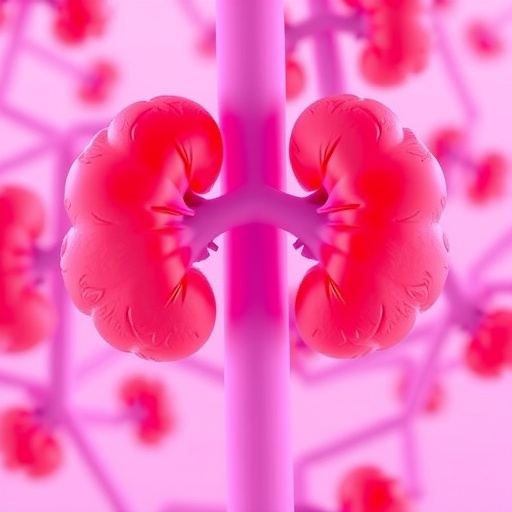A recent study published in the journal BMC Endocrine Disorders presents intriguing findings on the relationship between serum tumor markers and diabetic nephropathy among individuals with type 2 diabetes. This cross-sectional survey conducted in Western China has unveiled critical insights that could pave the way for potential advancements in the management and understanding of diabetic nephropathy, a serious complication of diabetes characterized by the progressive loss of kidney function.
Diabetic nephropathy, a condition affecting a significant number of individuals with type 2 diabetes, poses a considerable threat to renal health and overall quality of life. The condition’s complexity underscores the need for effective monitoring and early intervention strategies. Researchers have been exploring various biomarkers to enhance predictive capabilities for diabetic nephropathy, and this study is a significant step in that direction, focusing on serum tumor markers as potential indicators.
In this comprehensive survey, researchers Tao et al. engaged a diverse cohort of type 2 diabetes patients, investigating the role of tumor markers in predicting the onset and progression of diabetic nephropathy. The underlying hypothesis was based on accumulating evidence suggesting a connection between cancer markers and kidney disease. Their findings highlight the complex interplay between different physiological processes that may serve as critical signals for kidney health.
The study meticulously analyzed various serum tumor markers, showcasing their levels in patients with diabetic nephropathy compared to those without the condition. The research team employed rigorous methodologies to ensure the validity and reliability of their results. This included controlling for confounding variables such as age, gender, duration of diabetes, and associated comorbidities. By carefully delineating the sample population, the authors aimed to produce findings that could be extrapolated to broader populations.
Among the most striking findings was the correlation between elevated levels of certain serum tumor markers and the severity of diabetic nephropathy. This raises poignant questions about the biological mechanisms that underlie these associations. Could it be that the presence of these markers indicates not only cancer predisposition but also renal compromise? The implications of such a dual role can transform clinical practices, prioritizing the need for comprehensive screening across various disease spectrums.
Potential biological mechanisms linking serum tumor markers to kidney function deterioration are under investigation. Increased inflammatory markers and oxidative stress are known contributors to both cancer progression and renal damage. The findings from this study prompt further exploration of whether interventions that target these pathways could mitigate risks associated with diabetic nephropathy in diabetic patients.
Moreover, the geographical specificity of the study is noteworthy. Conducting this research in Western China highlights the potential variability in disease manifestation based on regional health dynamics, genetics, and lifestyle factors. Understanding these nuances is crucial for developing tailored health strategies to combat diabetic nephropathy. Regional studies of this nature contribute vital information that can either corroborate or contradict global health trends, enriching the knowledge base in nephrology.
The implications of this research extend beyond academia into clinical practices. If the associations observed in Western China can be replicated in diverse populations, clinicians worldwide may begin to integrate serum tumor marker screenings into their routine assessments for patients with type 2 diabetes. This could significantly enhance the early detection of diabetic nephropathy, allowing for timely and targeted therapeutic interventions.
Furthermore, the broader healthcare community should consider the cost-effectiveness of implementing such biomarkers as standard practice in monitoring patients with diabetes. By harnessing the predictive power of serum tumor markers, healthcare providers could potentially reduce the financial burden associated with advanced renal disease management. Early intervention is usually less costly and more effective than late-stage treatment, emphasizing the urgency of adopting methodologies that improve outcomes for diabetic patients.
Continuing the conversation around ethical considerations in this research is also pertinent. As the study highlights the role of tumor markers, it also raises concerns about overdiagnosis and the psychological impact on patients who may be concerned about potential cancer associations. Thus, any widespread implementation of screening should be accompanied by comprehensive educational initiatives aimed at demystifying the results and promoting informed decision-making among patients.
The significance of this research underscores the urgent need for ongoing investigations into the multifaceted relationships between diabetes, its complications, and potential biomarkers. Diabetic nephropathy serves as a prime example of how one condition can significantly influence overall health, necessitating a holistic approach in patient care. The intersection of oncology and nephrology may unveil novel pathways for the prevention of complications related to chronic diseases.
As the medical world begins to absorb these findings, it becomes clear that collaboration among researchers, clinicians, and policymakers is essential. By creating platforms for multidisciplinary discussions and sharing insights among various specialties, the healthcare sector can foster innovations that better address the pressing issue of diabetic nephropathy and other diabetic complications.
In conclusion, the study by Tao et al. serves as a critical reminder of the evolving landscape of diabetes research. As we stand on the brink of new discoveries that may redefine how we understand and manage diabetic nephropathy, the importance of thorough, methodologically sound research cannot be overstated. Future investigations should seek to clarify the pathways illuminated by this study, potentially leading to breakthroughs that alleviate the burden of diabetic nephropathy and improve the lives of those affected worldwide.
Subject of Research: Diabetic nephropathy in type 2 diabetes patients and its association with serum tumor markers.
Article Title: Association between serum tumor markers and diabetic nephropathy in type 2 diabetes patients: a cross-sectional survey in Western China.
Article References:
Tao, L., Yao, T., Zhang, Y. et al. Association between serum tumor markers and diabetic nephropathy in type 2 diabetes patients: a cross-sectional survey in Western China.
BMC Endocr Disord 25, 150 (2025). https://doi.org/10.1186/s12902-025-01932-1
Image Credits: AI Generated
DOI: 10.1186/s12902-025-01932-1
Keywords: Diabetic nephropathy, type 2 diabetes, tumor markers, serum biomarkers, chronic kidney disease.




